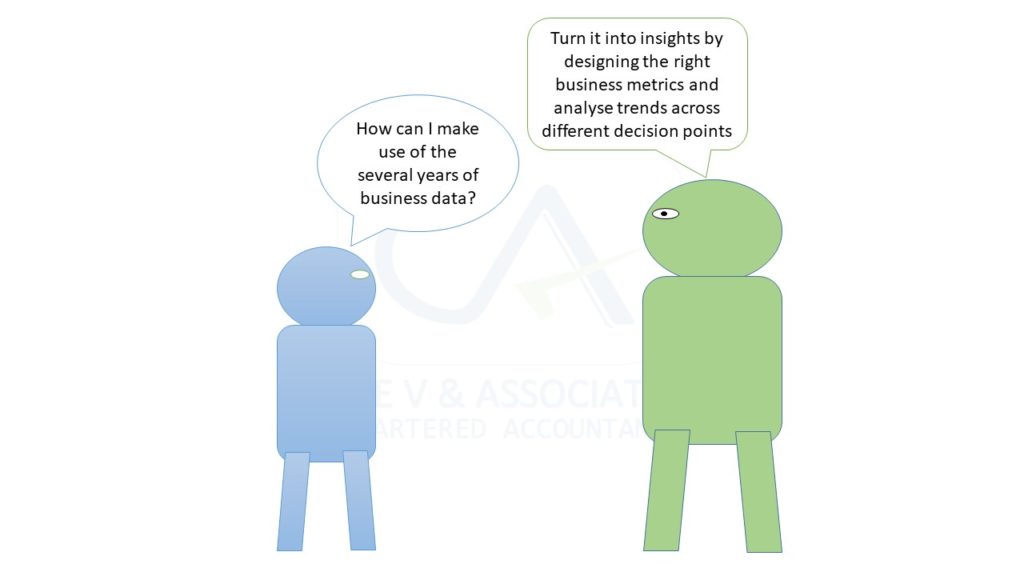This Corporate MD/CEO was running a monopoly business and market was favourable for business growth. Business process was all set and all sales & expenses data were managed in a traditional Accounting System managed by his Senior Accountant. The Senior Accountant used to give figures as required for the MD, but the MD was not fully happy as it was not fully aiding him in managerial decision making. The effort that he had to take to understand the numbers in the right context was so huge that most of the times he gave up on numbers and started using gut feel to drive the decisions.
That’s when he approached us as he wanted help in validating his decisions such as salary increment for staff, new product design, top 10 profitable clients to focus on etc. He had data from past 4 years in a spreadsheet and the financial statements from the Accounting system, but was not able to make sense out of these in such a way as to drive his decisions from it. Say for example salary increments for the team where decided mostly based on their claims rather than what the data told.
Data is like oil, but you have to mine it and create insights to generate value
We had a detailed workshop with him to understand his requirements in detail and approached the problem in the following manner:
- Design the right dashboard (metrics to be measured) that could give the CEO all the answers that he is looking for
- Create that dashboard from the existing data and validate his recent management decisions
- Automate the manual and error prone process of data collection and MIS report creation, so that what we designs continue to live for the business
We didn’t wanted to burden the costs of a sophisticated technology solution on the business, without getting their experience buy-in. So our team got together and created dashboards in Microsoft Excel using its Power Pivot functionality. Slicers across dimensions and timeline features along with data model using Excel tables created the perfect dashboard for the CEO. Client master, Product Master, Employee master and Location master were created out of the existing data to start with. All design decisions where taken in conjunction with the CEO through a series of white board meetings.
It took three rounds of iterations to fine tune the dashboard to meet the specific business requirements.

Once the Report with past data was created, CEO was able to get different perspectives including top revenue clients, top productive employees, top products and so on. He had many surprise elements which challenged his gut feel about how the business is performing and what his staff was claiming. This created a positive management mindset for having an MIS dashboard created on a monthly basis. But existing process inefficiencies needed to be removed before the entire thing could be automated.

We studied the data trail existing and found too many manual interventions and data quality issues. However, it was not the right time to suggest any technology investments as we wanted to prove the benefit of a regular data driven decision making process before they make any significant investment. So, we created data collection forms where employees could add new clients and create sale entries on a daily basis. Dropdown and validation rules in the Google forms ensured that there are minimum data quality issues going forward. The previous data entry person was entrusted the responsibility of taking this data from Google forms and populating it in the MIS sheet to get the monthly dashboard just at the click of a button.
Now employee incentives and new product launches are planned based on this MIS dashboard. Now we are in discussion with the CEO about building a custom system using mobile apps to make the system more sophisticated and user friendly. Since the usability and efficiency is proven already, CEO is not hesitant to make the investment.
We were happy that MIS we co-created, catered to the needs of the management. Our inhouse team had a major role to play in the creation as well as continuous development of the MIS. The MIS dashboard is continuing to evolve with the needs of the management, its business and the evolution in technology. Finally my client is able to drive decisions based on numbers and the message to achieve growth is communicated to all levels of the organizations via these numbers – numbers telling the story.
We are now in the process of spreading the best practices from this experience to our other clients and we have a ready prototype (with masked data) to showcase the benefits.
Yes, Data is Oil – provided you mine insights out of it …

